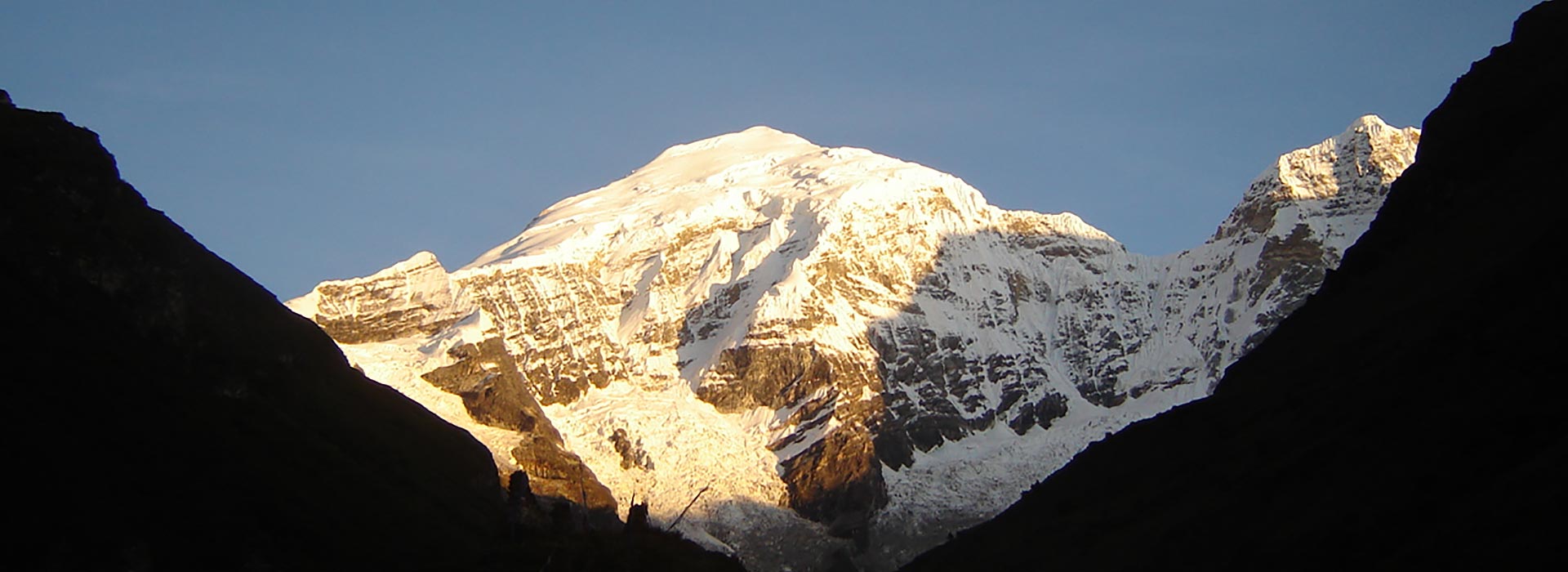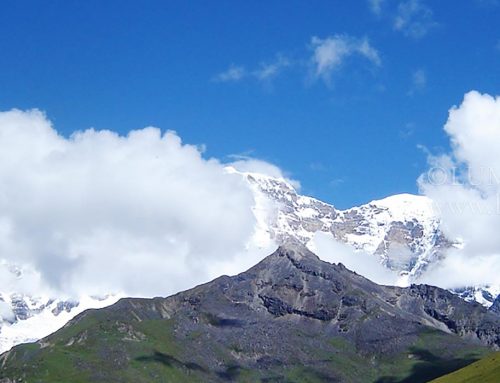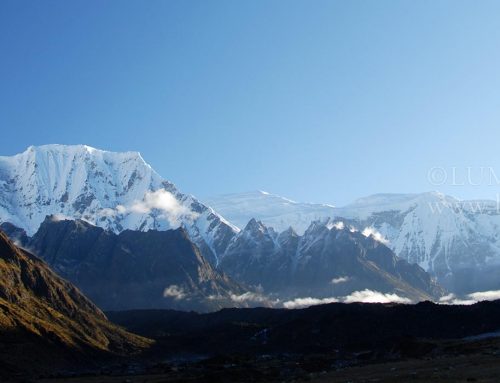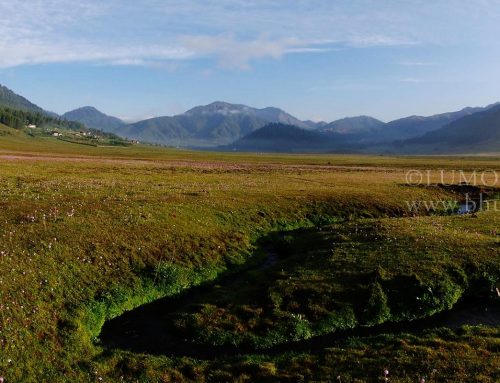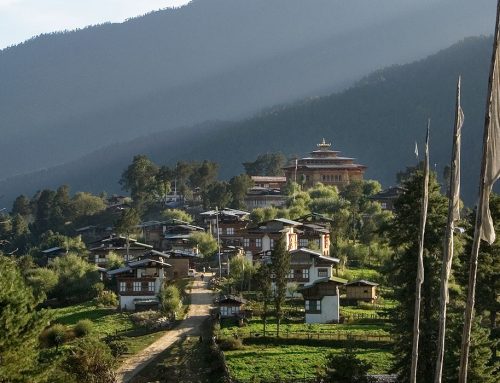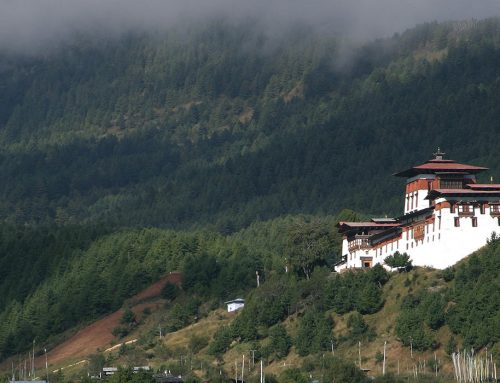- Duration: 13 nights / 14 days.
- Accommodation: Hotels, Resorts and Tents.
- Activity Type: Walking, Trekking & Tour.
- Difficulty Level: Strenuous.
- Highest Point: 4115 meters.
- Group size: Minimum 2 pax
- Best Months for the Trek: March – June, September – 2nd Week of December.
- You can spot Blue sheep and other exotic wild animals.
- You can also come across the Yak Herders’ camp in the Upper Himalayas.
- Spectacular view of Mt. Jhomolhari (7314m) and other mountains.
- Excursion to the famous Taktsang Monastery (Tiger’s Nest).
- Visit to Drugyal Dzong, Kichu Monastery, Memorial Chorten, the tallest Buddha Statue, Punakha Dzong, and Chimi Lhakhang (Temple of Fertility).
- A panoramic view of the higher Himalayas from the Dochula Pass (3140m).
This is a classic 9-day trek starting from (Drugyal Dzong) Paro and ending at Dodena near Thimphu. The route runs through two high passes from Jangothang. The view of Mt. Jumolhari (7314 M) from Jangothang is spectacular. The trek is strenuous and is very popular. The highest point is 4115 m.
DAY 01. ARRIVE AT PARO, 2280 METERS, BY DRUK AIR:
The flight into Paro is a befitting introduction to the spectacular beauty of Bhutan. In clear weather, you will be able to see some of the world’s highest peaks as you fly into Paro. As the aircraft prepares for landing, you will be surrounded by the lush green valleys. On landing, your Bhutanese escort from Druk & Drukpa Travel will greet you at the exit terminal, and then drive you the short distance to the Hotel.
After lunch, we will drive you to the ruins of the Drukgyal Dzong (Victory Fortress) about 16 km away from Paro town. Built in 1647 by the great Shabdrung Ngawang Namgyel, father and unifier of medieval Bhutan, the dzong was destroyed by fire and has been in ruins since then – an evocative reminder of the great victories it was built to commemorate. On a clear day you will see an unforgettable view of Mt. Jhomolhari (7,314 m), the highest unclimbed peak in the world. On the way back, visit Kichu Lhakhang that was built in 659 AD by the Tibetan King Srongsen Gampo. In the evening, you are free to stroll in the town. Dinner and overnight in a hotel.
DAY 02. PARO, 2280 METERS: EXCURSION TO TAKTSANG MONASTERY:
After breakfast a short drive will take you to Satsam Chorten, from where you start your 2-hour hike to view the spectacular Taktsang (Tiger’s Nest) monastery. The trail climbs through beautiful pine forests. You will stop for a rest and light refreshments at the Taktsang Zakhang (cafeteria) and then walk a short distance until you see, clearly and seemingly within reach, the famed Taktsang Monastery. Built in the 1600s, this incredible monastery clings to the edge of a sheer rock cliff. It is said that Guru Padmasambhava, the tantric mystic who brought Buddhism to Bhutan, came to Taktsang riding on a tigress.
After lunch, visit Ta Dzong, an ancient watchtower, which now houses the National Museum. Below the museum is the Paro Rinpung Dzong, built in 1646 by Zhabdrung Ngawang Namgyal. A short walk takes you to the base of the dzong and you will cross the Pachhu River on a traditional cantilever bridge. Dinner and overnight in Hotel.
DAY 03. PARO – SHANA (START OF TREK):
Our trek to Shana starts at Drukgyal Dzong at 2580 meters following the Paro River and we pass cultivated fields and tiny picturesque villages. The forests are alive with numerous birds and bright-colored butterflies. Overnight at a camp in Shana.
Altitude 2,850 m; Distance 17 km; Time 5 – 6 hours; Ascent 360 meters, descent 80 meters.
DAY 04. SHANA – THANGTHANGKA:
The trail follows the river through a heavily forested area with a few isolated farmhouses. We pass a junction en route where another path leads north over the Tremo La to Tibet. Camp is in a meadow with a stone shelter.
Altitude 3610 m; Distance 22 km; Time 7 – 8 hours; Ascent 770 meters, descent 10 meters.
DAY 05. THANGTHANGKA – JANGOTHANG:
In the morning after passing a small army post, the trail slowly leaves the forest line and gradually climbs up to a beautiful valley, passing Tegethang, a winter home of yak herdsmen. Lunch will be served in one of these huts. You will come across a lot of yaks before we arrive at the Jhomolhari base camp (4,115 m). High mountains overlook the camp and visible nearby are the ruins of an old fortress used to guard Bhutan against Tibetan invasions.
Altitude 4080 m; Distance 19 kms; Time 5 – 6 hours; Ascent 480 meters.
DAY 06. JANGOTHANG:
Rest day at Jangothang, enjoy the superb view all around.
You have three options for day hikes in Jangothang:
- Hike to Jumolhari Glacier which is around 4 ½ hours (back and forth)
- Hike to Jichu Drake Glacier which is around 3 hours (back and forth).
- Walk up the mountain between Jumolhari and Jichu Drake, the summit is at 5200 meters with a great view of both the mountains. This is 8 hours (back and forth).
DAY 07. JANGOTHANG – LINGSHI:
The trail follows a stream for half an hour and crosses a bridge to the right side. Start the climb up to the first ridge with a breathtaking view of Mt. Jumolhari, Mt. Jichu Drakey, and Mt. Tsrim Ghang. Then walk towards the valley, almost flat for a while, until the climb to the Nyeleyla Pass at an altitude of 4,700 meters. After the pass it’s a gradual descent to the Lingshi camp. Enjoy the panoramic view of the peaks and Lingshi dzong.
Altitude 4010 meters; Distance 18 km; Time 6-7 hours; Ascent 840 meters, descent 870 meters.
DAY 08. LINGSHI – SHODU:
The trail today climbs to Yalila Pass (4930 m), from where on a clear day impressive views of Mt. Jumolhari, Mt. Tserim Kang and Mt. Masagang can be seen. Dinner and overnight in a camp.
Altitude 4080 meters; Distance 22 km; Time 8-9 hours walk; Ascent 940 meters, descent 920 meters).
DAY 09. SHODU – BARSHONG:
The path follows the Thimphu River, descending through rhododendron, juniper and other alpine forest. The view of the cliff facing rocks and waterfalls are stunning. Hot lunch will be served by the riverside. After lunch the trail gradually ascends to the ruins of the Barshong Dzong, reaching the camp. Dinner and overnight in a camp.
Altitude 3710 meters; Distance 16 km; Time 5-6 hours; Ascent 250 meters, descent 670 meters.
DAY 10. BARSHONG – DOLAMKENCHO:
The road descends through alpine forest and we once again join Thimphu River for a while. After lunch we climb up to Dolamkencho camp.
Altitude 3320 meters; Distance 15km; Ttime 4-6 hours; Ascent 290 meters, descent 640 meters.
DAY 11. DOLAMKENCHO – DODENA – THIMPHU:
The path descends through bamboo forests finally joining the Thimphu River again. Arrive at Dodena where you will be picked up for the drive to Thimphu. Overnight at a hotel.
Distance 8 km; 4 hours walk;Ascent 500 meters, descent 930 meters.
DAY 12. THIMPHU SIGHTSEEING:
The day begins with a visit to the National Memorial Chorten, built in honour of the late King Jigme Dorji Wangchuck, and the Dupthop Lhakhang, one of the few surviving nunneries in Bhutan. We then visit the National Library, which displays the ancient Buddhist manuscripts, and the Painting School where the traditional Bhutanese art is still kept alive. After lunch we drive to the National Institute of Traditional Medicine and to Lungtenzampa to observe the royal silver smiths and a traditional paper factory. Other highlights of the sightseeing include a visit to the Tashichhodzong, seat of the national government and the Central Monastic Body, including the summer residence of the Je Khenpo (Chief Abbot of Bhutan). We then drive to Simtokha Dzong, the oldest Dzong of Bhutan built by Shabdrung in 1627, and finally visit the Handicrafts Emporium where you may buy souvenirs. Overnight in a hotel.
DAY 13. THIMPHU- PUNAKHA – THIMPHU:
After breakfast, we will drive to Punakha through Dochula Pass. If the weather is clear, you will see a spectacular view of the higher Himalayas at Dochula. After lunch at Punakha, you will visit the Punakha Dzong. Built in 1637 by Zhabdrung Ngawang Namgyal, the sprawling fortress is situated between Pho Chu (Male River) and Mo Chu (Female River). For many years until the time of the second king, it served as the seat of the government. There was a smaller building here called Dzong Chu (Small Dzong) that housed a statue of Buddha. It is said that Zhabdrung ordered the architect, Zowe Palep, to sleep in front of the statue, and while Palep was sleeping, the Zhabdrung took him in his dreams to Zangtopelri and showed him the palace of Guru Rimpoche. From this vision, the architect conceived the design for the new Dzong. The Dzong was named Druk Pungthang Dechen Phodrang (Palace of Great Happiness). The war materials, mostly weapons and protective gears, captured during the battle with Tibetans are preserved here. Punakha is still the winter residence of Je Khenpo. The first National Assembly of Bhutan was convened here in 1952. In the evening, drive back to Thimphu. Overnight in a hotel.
DAY 14. THIMPHU – PARO AIRPORT (DEPARTURE):
Early morning drive to the airport and farewell.
- Day hike to Jumolhari Glacier which is around 4 ½ hours (back and forth)
- Day hike to Jichu Drake Glacier which is around 3 hours (back and forth).
- Walk up the mountain between Mt. Jumolhari and Mt. Jichu Drake, the summit is at 5200 meters with a great view of both the mountains. This is 8 hours (back and forth).
- Excursion to Chelela Pass.
Cost inclusive of:
- All Meals [Breakfast /Lunch/Dinner]
- Accommodation [Twin Sharing] Single Room Supplement Extra US $: 40 per room per night.
- All transportation within the country including airport transfers.
- Royalty & Govt. Taxes
- Entrance fees for Museums and Monuments only
- Visa Fee
- Airport tax
- Contribution to Tourism Development Fund
- Guide
- Sightseeing
While on trek, cost covers:
- Nature Recreation and Ecotourism Division (NRED) Nu.1000
- 3 meals a day
- Service of cook & helper
- Guide, sleeping tent
- Mess Tent, Kitchen Tent & Toilet Tent
- Ponies to carry supplies
- Royalty
- We will provide you with sleeping mats but you have to bring your own sleeping bags.
Cost exclusive of:
- Druk Air fare
- Insurance Premiums
- Payments for service provided on a personal basis
- Cost for any services not mentioned in the “Cost Include Head”
- Cost incurred due to mishaps, strikes, political unrest, etc.
- Personal expense in items such as laundry, soft drinks, camera charges, bottled water, incidentals, portage, bellboy charges, tips or any other services
Personal clothing: strong normal clothing (according to season). Preferably cotton, even for summer, woolen clothing for the evening and winter.
For Trekking, one must bring:
- Strong comfortable trekking boots – water-resistant for the rainy period of June-August
- Sunscreen
- Flash light
- Rain coat (especially for rainy period – June-August)
- Head gear/hat/cap for sun and rain protection
- Water pills – for extra caution in purifying stream; (boiled water is provided at all times during the trek)
- Aspirin – incase of altitude sickness
- Lots of socks
- Warm clothes
OPTIONAL ITEMS
- Sunglasses
- Headgear
- Folding umbrella (only for wet months — July and August)
- One towel
- Pillow case
- Wet-packed tissue paper
- Pillow


